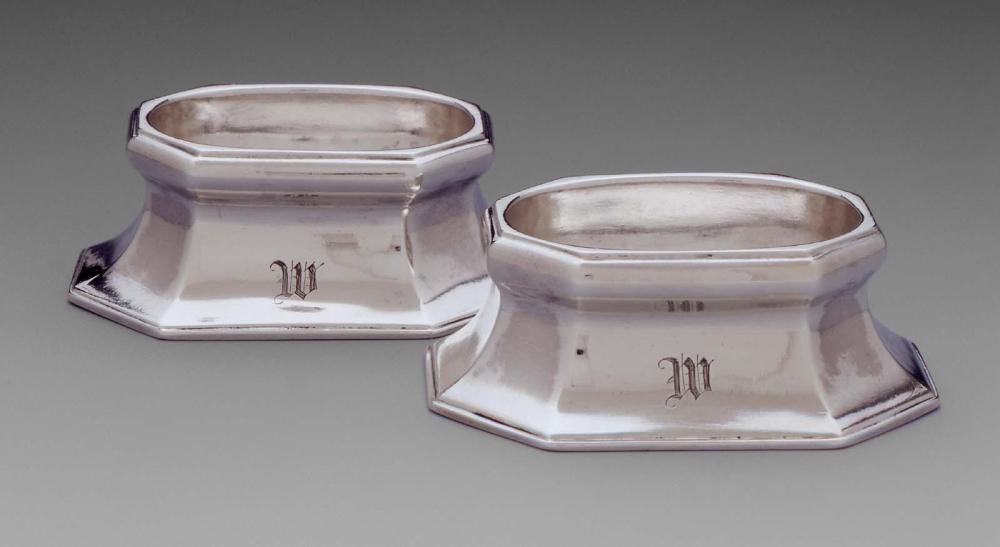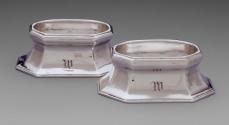Advanced Search
Trencher Salt (one of a pair)
John Coney (American, 1655 or 1656–1722)
1710–20
Object Place: Boston, Massachusetts
Medium/Technique
Silver
Dimensions
2.8 x 7.8 x 6.1 cm (1 1/8 x 3 1/16 x 2 3/8 in.)
Credit Line
Gift of Mr. and Mrs. William L. Payson
Accession Number1973.618
CollectionsAmericas
ClassificationsSilver hollowware
The trencher salt, intended for placement at each diner’s trencher, or plate, was first used at English and American tables during the early eighteenth century. Its modest scale followed the majestic spool-shaped salts of the late seventeenth century that were traditionally placed near the head of the household and whose size alone commanded respect for the rare commodity they contained. As local saltworks became established along the Massachusetts coast, and the spice was obtained locally, the trencher salt came into use in several low forms that were sometimes made in pairs.
The octagonal trencher salt, actually a rectangular form with canted corners and an oval interior, was popular in England but rarely seen in the colonies. This pair is unique in Coney’s oeuvre. According to family tradition, the salts were a wedding gift to Lydia Bowes from John Hancock; but due to their likely date of fabrication, he probably inherited them from his uncle Thomas Hancock (1703 – 1763), a merchant. Aside from another pair by Coney that are oval, an example made about 1730 by Jacob Hurd, and a pair dated 1745 and made by Joseph Richardson Sr., apparently few salts of this shape were made in the colonies.
According to family history, the salts were traditionally used with a pair of later Jacob Hurd salt spoons (cat. no. 81). Hancock’s wedding gift to Bowes also included a tankard by London silversmith Thomas Moore II and a creampot by Samuel Gray.
This text has been adapted from "Silver of the Americas, 1600-2000," edited by Jeannine Falino and Gerald W.R. Ward, published in 2008 by the MFA. Complete references can be found in that publication.
The octagonal trencher salt, actually a rectangular form with canted corners and an oval interior, was popular in England but rarely seen in the colonies. This pair is unique in Coney’s oeuvre. According to family tradition, the salts were a wedding gift to Lydia Bowes from John Hancock; but due to their likely date of fabrication, he probably inherited them from his uncle Thomas Hancock (1703 – 1763), a merchant. Aside from another pair by Coney that are oval, an example made about 1730 by Jacob Hurd, and a pair dated 1745 and made by Joseph Richardson Sr., apparently few salts of this shape were made in the colonies.
According to family history, the salts were traditionally used with a pair of later Jacob Hurd salt spoons (cat. no. 81). Hancock’s wedding gift to Bowes also included a tankard by London silversmith Thomas Moore II and a creampot by Samuel Gray.
This text has been adapted from "Silver of the Americas, 1600-2000," edited by Jeannine Falino and Gerald W.R. Ward, published in 2008 by the MFA. Complete references can be found in that publication.
DescriptionThis low octagonal salt is of roughly rectangular shape with two long and six shorter sides. The shallow oval bowl is set within a faceted body having concave sides that splay inward from wide, scored base. The foot is reinforced with applied wire.
Marks
On underside of bowl is stamped "I C" crowned, and over a coney, all within a shield.
InscriptionsInscribed "A/T*H" in roman capitals on base. Later inital "W" on exterior in Gothic capitals along length of trencher.
Provenance1770, Possibly given by John Hancock to his cousin Lydia Bowes (1749-1805) on her marriage to Rev. Phineahas Whitney (1740-1819) of Shirley; (1) by descent to Mrs. Thomas B Coolidge (Eleanor Whitney Watson) (b 1902), Mrs T Dana Hill (Marjorie) (b 1903) and Mrs William Payson; 1935, Lent by Mrs. Coolidge, Mrs. Hill, & Mrs Payson to the MFA; 1958, purchased by Mr and Mrs Payson from her sisters; 1973, gift of the Paysons to the MFA. (Accession date: )
1: to their son Thomas Whitney (1771-1884) m.1799 Henrietta Parker (1775-1864); to their son James Phineas Whitney (1802 – 1847) and Lydia Bowes Parker Treadwell (b. 1815), m. 1836; to their daughter Henrietta Parker Whitney (1837 – 1900) and Andrew McFarland Davis (b. 1833) of Worcester, m. 1862. To their daughter Frederica King Davis (1869 – before 1964) and Thomas Russell Watson (1850 – 1920) of Plymouth and Middletown, m. 1901; to their three daughters.
1: to their son Thomas Whitney (1771-1884) m.1799 Henrietta Parker (1775-1864); to their son James Phineas Whitney (1802 – 1847) and Lydia Bowes Parker Treadwell (b. 1815), m. 1836; to their daughter Henrietta Parker Whitney (1837 – 1900) and Andrew McFarland Davis (b. 1833) of Worcester, m. 1862. To their daughter Frederica King Davis (1869 – before 1964) and Thomas Russell Watson (1850 – 1920) of Plymouth and Middletown, m. 1901; to their three daughters.



